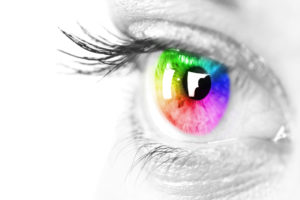Table of Contents
Color blindness is a condition in which a person is incapable of detecting certain colors in the color spectrum. This inability to recognize colors stems from the absence of pigments in one or all of the three cone-shaped photoreceptor cells responsible for color vision inside the retina. Red and green color vision deficiency is the most prevalent form of color blindness with some exceptions where there is insensitivity to yellow and blue colors in addition to red and green. Some people are unable to perceive any color at all and all the colors appear to them as different shades of grey.

SYMPTOMS OF COLOR BLINDNESS
A majority of people suffering from color blindness are unaware of the problem and it is not until someone else notices their inability to perceive some specific colors that they know that they are color blind. To have a true idea of whether a person is color blind or not, one must undergo color blindness test. Each person exhibits a unique set of symptoms which are contingent on the intensity of the color blindness. These include :
Inability to detect the brightness of certain colors like red and green. These colors may appear dull to some color blind people.
Difficulty in being able to tell the difference between different shades of red, green, yellow and blue.
Seeing some colors in different shades like seeing red as black, blue as red or all the colors as shades of grey.
It’s often difficult to identify color blindness in children who were born with this eye condition. Hence, it’s important for parents to look for signs of color blindness in children right from the beginning and get them tested by an ophthalmologist to prevent any more damage to the vision.
CAUSES OF COLOR BLINDNESS
The primary cause of color blindness is the absence of cone-shaped cells or pigments in those cells inside the retina. This absence is triggered by a number of factors including heredity – where the problem is passed from the mother to the offsprings. Diseases like multiple sclerosis, glaucoma, diabetic retinopathy, optic neuropathy, age-related macular degeneration, Parkinson’s Disease and Kallman’s syndrome also influence color vision. In some cases, this condition may be brought on as a side effect of certain medications or exposure to chemicals like carbon monoxide, carbon disulfide, and lead.
TREATMENT OPTIONS
At present, there is no treatment available for color blindness. However, there is an option for some color blind individuals to enhance their color sensitivity by wearing glasses or lenses with special filters to help them perceive colors correctly. These filters alter the wavelengths of colors to make them identifiable to the sufferers. Those who are completely color blind can take help of a device called eyeborg that helps in observing colors through sound waves.
Scientists are working on bringing in gene therapy as a cure for color blindness in humans. This therapy involves injecting genes in the retina to correct the abnormalities in photoreceptor cells. This therapy has shown positive results in trials performed on monkeys and it may take a few more years for this therapy to become a standardized treatment for humans with no side effects.
Author Bio
Harvey Lee is a health and beauty blogger and works with various industry leading health and beauty product brands e.g. EyeSoothe: UK’s leading Eye Mask brand for various eye issues including Blepharitis, MGD, Dry eye syndrome and more. Harvey strongly recommends seeking physician opinion before replacing medication with natural or other non-clinical remedies.



